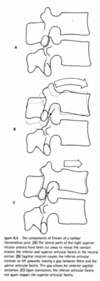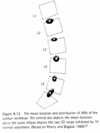Week 1: Tuesday (1/12/16) Lumbar Anatomy & Arthrokinematics Prep Guide + Notes from class Flashcards
What is the function of the curves in the spinal column (in other words, why specifically is a curved spine better than a straight spine)?
- [Helps] Minimize compression force to reduce load through vertebral bodies (Mincer video)
- The sagittal plane curvatures of spine provide strength and resilience to axial skeleton. A reciprocally curved vertebral column acts like an arch. Compression forces between vertebrae are partially shared by tension in stretched connective tissues and muscles located along the convex side of each curve. Similar to long bones like the femur, the strength and stability of the vertebral column are derived, in part, from its ability to “give” slightly under a load, rather than to support large compression forces statically. (pg 314 Neumann)
What is the main function of the vertebral body?
What other structure helps with this function?
- The drum-shaped vertebral body, designed to bear weight and withstand compression or loading. (knowyourback.org)
- Intervertebral discs also serve this function.
Besides bearing weight and withstanding compression or loading, is another important function of a vertebral body?
The upper and lower surfaces of the vertebra body give attachment to the intervertebral discs. (wikipedia)
In general where is the axis of rotation for intervertebral movement?
Why is it helpful to know this?
- The axis of rotation for intervertebral movement is near or through the region of the vertebral body.
- Helpful to know because we can remember that With sagittal plane movement, any ligament located posterior to the vertebral body is stretched during flexion. Any ligament located anterior to the vertebral body is stretched during extension. >>>directional orientation to spine is done at the the vertebral body. (Neumann pg 318)
What type of joint is a facet joint?
synovial
How do synovial joints get nutrition?
Small blood vessels with capillaries penetrate the joint capsule, usually as deep as the junction of the fibrous layer of the joint capsule and the adjacent synovial membrane. ( Neumann pg 29)
Can synovial joints be sources of pain?
Yes!
Sensory nerves also supply the external layer of the capsule and ligaments with receptors for pain and proprioception. (Neumann pg 29)
How can synovial joints be sources of pain?
Sensory nerves also supply the external layer of the capsule and ligaments with receptors for pain and proprioception. (Neumann pg 29)
In what way does the facet joint capsule act like a ligament?
Basically, the capsule is very similar to ligaments in structure and function
- (Neumann, pg 316) Capsular ligaments of the apophyseal joints consist mostly of collagen fibers that attach along the rim of the facet surfaces ( see fig 9-11, A). Those apophyseal joints help interconnect and stabilize the intervertebral junction. Also have a unique role in guiding the specific direction of intervertebral movement. Sensory mechanoreceptors embedded within the capsule likely provide muscles info to assist with this guidance.
- The capsular ligaments are relatively loose in the neutral position, but become taut as the joint approaches the extremes of all its movements. Passive tension is greatest in motions that create the largest translation or separation between joint surfaces.
What structure primarily determines the amount of spinal motion (flex/ext, lateral flex, rotation) in the lumbar region?
The facet joints and the orientation of their surfaces.
How do the facet joints of L1-L4 affect spinal motions (flex/ext, LF, rotation)?
L1-L4: The facet surfaces of most lumbar apophyseal joints are oriented nearly vertically (not great for horizontal plane rotation), with a moderate-to-strong sagittal plane bias (best for flex/ext).
- The orientation of the superior articulating facet of L2, for example, is on average about 25° from the sagittal plane. This orientation favors sagittal plane motion at the expense of horizontal rotation [and probably frontal plane lateral felxion]. (Neumann pg 346)

How do the facet joints of L5-S1 affect spinal motions (flex/ext, LF, rotation)?
L5-S1: The L5-S1 junction has an anterior interbody joint and a pair of posterior apophyseal joint (like any vertebral junction). However, the facet surfaces of the apophyseal joints have more of a frontal plane orientation than the other lumbar vertebrae. (Neumann pg 346)
- This restricts saggital plane movement (flex/ext) and horizontal plane movement (rotation)
- It allows frontal plane movements (lateral flexion).
- It also resists anterior translation of L5 on S1.
lumbar flexion/extion:
- What is the normal range given in Neumann for each movement?
- does L1-L4 or L5-S1 contribute to this motion the most?
- Lumbar Flexion= 40°- 50° (pg 350)
- Lumbar Extension= 15° - 20° (pg 350)
L1-4 contributes the most because of the almost saggital orientation of the facet joints (about 25 degrees from saggital plane).
lumbar lateral flexion:
- What is the normal range given in Neumann for this movement?
- does L1-L4 or L5-S1 contribute to this motion the most?
Lateral Flexion= 20° (pg 357)
L5-S1 contributes the most to this motion because of the frontal plane orientation of the facet joints.
Gravity imposes a much higher degree of ________ force at L5-S1 than the rest of the lumbar spine.
Gravity imposes a much higher degree of anterior shear force (and posterior compressive) force at L5-S1 than the rest of the lumbar spine.(Neumann pg 348)
The intervertebral foramen (IVF) is created by what bony structure(s)? (4)
- IVF is the lateral opening between adjacent vertebrae
- The Superior Notch of the adjacent vertebra (inferior to IVF)
- The Inferior Notch of the vertebra superior to the IVF
- The body of the vertebral body
- Facet joints on the transverse process of the vertebra.(310 and wikipedia)

What passes through the IVF? (6)
- root of each spinal nerve
- dorsal root ganglion
- the spinal artery of the segmental artery
- communicating veins between the internal and external plexuses
- recurrent meningeal (sinu-vertebral) nerves
- transforaminal ligaments. (wikipedia)
True/False: Adult intervertebral discs are essentially avascular
True
Adult discs are essentially avascular, so how does a disc receive nutrition? What is the effect of movement on this process?
- (Neumann, pg 330) Only the outer, more peripheral rings of annulus fibrosus contain blood vessels. For this reason, most of the disc has a limited healing capacity. Essential nutrients, such as glucose and oxygen, must diffuse a great distance to reach the deeper cells that sustain the disc’s low but essential metabolism. The source of these nutrients is in the blood vessels located in the more superficial annulus and blood stored in the adjacent vertebral bodies. most of these nutrients must diffuse across the vertebral end-plate and through the disc’s extracellular matrix.
- Movement causes a larger fluxuation in the water content of the disks and improves diffusion of nutrients into the disc (and waste out of the disk)
How can age affect the ability of nutrients to reach the intervertebral disc?
How does this affect the ability of the disk to handle loading?
Aged discs show reduced permeability and increased calcification of the vertebral end plates, which reduces the flow of oxygen and nutrients into the disc. This age related process can inhibit cellular metabolism and synthesis of proteoglycans. Less proteoglycan content reduces the ability of the nucleus to attract and retain water, limiting its ability to effectively absorb and transfer loads.
Describe the structure of the annulus
It is tough and strong, but subject to cracks and fisures as it ages.
- The annulus (in the lumbar disc) consists of 15 to 25 concentric layers of rings or collagen fibers (like dough surrounding the jelly in a doughnut). Materials and cells are similar with the nucleus pulposus but the proportion is different. In the annulus collagen make up about 50 to 60% of the dry weight as compared to 15 to 20% in the nucleus. Elastin protein is abundantly interspersed in parallel with the rings of collagen adding circumferential elasticity to the annulus.
- The outermost layer of annulus is primarily type I and type II collagen for strength and flexibility, as well as a mean of bonding the annulus to the ALL, PLL and to the adjacent rim of the vertebral bodies and end plates. Collagen fibers are arranged in multiple concentric layers, with fibers in every other layer running in identical directions (alternating) (fig. 9.34). The orientation of each collagen fiber is about 65 degrees from the vertical.
- The outer layer contain the disc’s only sensory nerves.
- The deeper internal layers contain less type I collagen and more water starting to gradually become similar in structure with the nucleus.

During flexion, what part of the annulus becomes taut? How many layers of this part are taut?
- The posterior portion becomes taut to resist the migration of the nucleus pulposus during extreme flexion. (pg 350)
- I believe all the fibers become taut.
- I think since the fiber layers alternate in oblique directions (at about 65 degrees from vertical), when a person flexes forward, all fibers become taut. This is different from if someone performed lateral flexion, where half of the fibers (those oriented in the opposite direction of side flexion) would become loose, while the remaining half would get extra-taut. I think this holds true for rotation as well. This explains one reason the annulus is more at risk during movements that involve twisting (rotation) and flexion, whereas it is safer to perform flexion in a neutral position.

What happens to the anterior annulus during flexion?
According to a book called Manual Physical Therapy, the anterior annular fibers become slack during flexion. (Not sure if this is what Mincer is looking for) - Sounds right to me (Sara)
- The anterior aspect of the disc is compressed (pg. 350)
- Nucleus moves slightly posterior
- Annulus becomes taut posteriorly and the anterior fibers become slack and bulge anteriorly.
- The nucleus pulposus of the disc is compressed anteriorly and pressure is relieved over the posterior surface.
If the flexed position is maintained for a couple of hours, what structural change does the posterior part of the annulus undergo and how does this affect its strength?
- Based on class discussion, I beleive she was asking us to identify the term “Creep”
- something called “Creep” occurs, which is a slow deformation of the tissue over time when exposed to stress that is below the yield strength of the tissue. This is a mechanical property of soft tissue that is related to its viscoelastic properties
- Creep reduces strength of the tissue.














